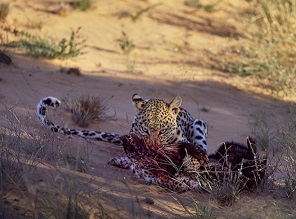Interactions
Within their environment, honey badgers are seen as one of
the most alarming species due to their fearlessness of danger
and predators around them. In general, honey badgers tend to
keep to themselves due to their relatively independent nature.
The mothers in general take care of their newborns but the males
typically tend to travel on their own (Mueller, 2014). With
their high temperament and disregard of other species, it is not surprising that they generally keep to themselves. As a smaller
species in an environment with various amounts of predators, the
honey badger must always be on its guard for potential
attackers. Even though in general honey badgers maintain their
solitude, there are certain areas where they meet to sniff
around and mark the ground with their scent (“Honey Badger (Ratel),” 2014). This is where honey badgers may
discover potential mates and interact within their population.
For communication purposes, the Mellivora capensis can produce a
variety of sounds. Generally the honey badger communes in series of
grunts, squeaks, whines and hisses, yet they’re most noted for their
profound and menacing growl (“Honey Badger”, 2014). When observing
the honey badger when battling with predators, you can clearly hear
its projected growl as it fends off potential threats. You can
observe the honey badger in a stiff battle with a hyena in the video
below! The fearless honey badger is able to fend off its
attacker without any harm done. For protective purposes, their growl
can be utilized.
In general context to other species, the honey badger could
generally be seen as a predator, due to its wide diet variety as
seen on the Nutrition page. With a landscape that is littered with
many various predators, the honey badger does have to compete for
its food, though their strong jaws and sharp claws give them proper
tools to achieve their meal. 
In their terrestrial area, the honey badger truly has only a
relatively small amount of predators, mainly due to their fearsome
attitude and other strong characteristics. Some of their predators
within the African area may include
lions,
leopards, or other fairly
larger predators. One thing for certain is that the honey badger
doesn’t go down without a fight. There is a story how once an
elderly female honey badger with almost no teath and blindness in
one eye withstanded a leopard attack for nearly one hour (“Honey Badger,” 2014). If one thing’s for
certain, the honey badger should never be underestimated.
Despite being widely spread throughout the African environments,
there are some instances
 where humans utilize the honey badgers as
well. Honey gatherers located within the Kalahari environment
utilize various types of honey-intrigued species (known as honey
guides) to technically lead the gatherers to various sources of
honey. Species such as the honey badgers are used to track down
where the natural beehives are located within the area so honey can be
collected (Isack, 1989). Apart from their honeyguide
abilities, honey badgers are notorious for disrupting beekeeper
hives all throughout Africa. Traditional beekeepers are forced
to take precautions by hanging their hives up on the bark of trees
or surrounding them with protective barricades to prevent
destruction. Despite the beekeepers best efforts, the honey
badger still acounts for thousands of bee hive destructions each
year (Begg, 2012).
where humans utilize the honey badgers as
well. Honey gatherers located within the Kalahari environment
utilize various types of honey-intrigued species (known as honey
guides) to technically lead the gatherers to various sources of
honey. Species such as the honey badgers are used to track down
where the natural beehives are located within the area so honey can be
collected (Isack, 1989). Apart from their honeyguide
abilities, honey badgers are notorious for disrupting beekeeper
hives all throughout Africa. Traditional beekeepers are forced
to take precautions by hanging their hives up on the bark of trees
or surrounding them with protective barricades to prevent
destruction. Despite the beekeepers best efforts, the honey
badger still acounts for thousands of bee hive destructions each
year (Begg, 2012).
It's clear that the honey badger plays a diverse role within its niche. To learn some more fun info related to this species, check out the Facts page!
